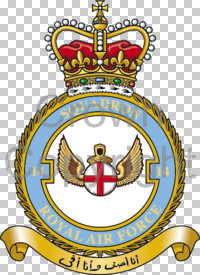No 14 Squadron, Royal Air Force: Difference between revisions
Jump to navigation
Jump to search
Knorrepoes (talk | contribs) m (Text replacement - "{{uk}} ↵↵''' {{uc" to "''' {{uc") |
Knorrepoes (talk | contribs) m (Text replacement - "Category: " to "Category:") Tags: Mobile edit Mobile web edit |
||
| (One intermediate revision by the same user not shown) | |||
| Line 14: | Line 14: | ||
The Winged plate with the St George's Cross symbolise World War I service in Palestine. It was then based near the reputed burrial site of the Saint. The Motto is from the Koran and was suggested of Emir Abdullah of Transjordan. | The Winged plate with the St George's Cross symbolise World War I service in Palestine. It was then based near the reputed burrial site of the Saint. The Motto is from the Koran and was suggested of Emir Abdullah of Transjordan. | ||
[[Literature]]: Image from Defence Brand Portal, Ministry of Defence | [[Literature]]: Image from Defence Brand Portal, Ministry of Defence | ||
[[Category:Military heraldry of the United Kingdom]] | [[Category:Military heraldry of the United Kingdom]] | ||
[[Category:Air Force heraldry]] | [[Category:Air Force heraldry]] | ||
[[Category: Granted 1937]] | [[Category:Granted 1937]] | ||
Latest revision as of 10:23, 15 October 2023
NO 14 SQUADRON, ROYAL AIR FORCE
History: Raised at Shoreham, Sussex on 3 February 1915.
Official blazon
A winged plate (the wings Or) charged with a cross gules throughout surmounted by the head and shoulders of a suit of armour proper.
Motto: in Arabic translating as I spread my wings and keep my promise.
Origin/meaning
The Winged plate with the St George's Cross symbolise World War I service in Palestine. It was then based near the reputed burrial site of the Saint. The Motto is from the Koran and was suggested of Emir Abdullah of Transjordan.
Literature: Image from Defence Brand Portal, Ministry of Defence
